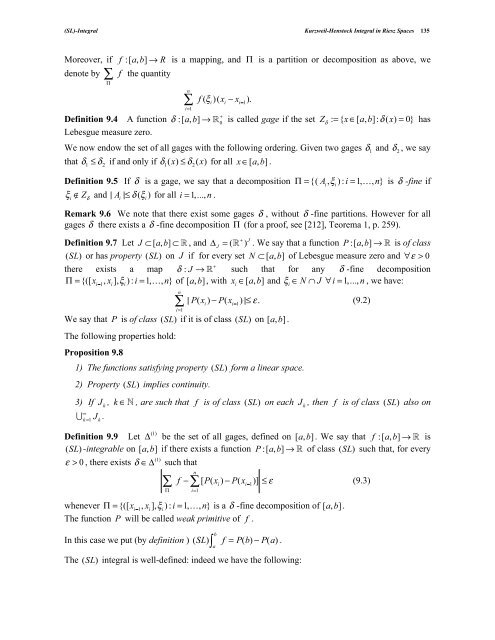Kurzweil-Henstock Integral in Riesz spaces - Bentham Science
Kurzweil-Henstock Integral in Riesz spaces - Bentham Science
Kurzweil-Henstock Integral in Riesz spaces - Bentham Science
You also want an ePaper? Increase the reach of your titles
YUMPU automatically turns print PDFs into web optimized ePapers that Google loves.
(SL)-<strong>Integral</strong> <strong>Kurzweil</strong>-<strong>Henstock</strong> <strong>Integral</strong> <strong>in</strong> <strong>Riesz</strong> Spaces 135<br />
Moreover, if is a mapp<strong>in</strong>g, and is a partition or decomposition as above, we<br />
denote by the quantity<br />
Def<strong>in</strong>ition 9.4 A function<br />
Lebesgue measure zero.<br />
is called gage if the set has<br />
We now endow the set of all gages with the follow<strong>in</strong>g order<strong>in</strong>g. Given two gages and , we say<br />
that if and only if for all .<br />
Def<strong>in</strong>ition 9.5 If is a gage, we say that a decomposition is -f<strong>in</strong>e if<br />
<br />
and for all .<br />
Remark 9.6 We note that there exist some gages , without -f<strong>in</strong>e partitions. However for all<br />
gages there exists a -f<strong>in</strong>e decomposition (for a proof, see [212], Teorema 1, p. 259).<br />
Def<strong>in</strong>ition 9.7 Let , and . We say that a function is of class<br />
or has property on if for every set of Lebesgue measure zero and<br />
there exists a map such that for any -f<strong>in</strong>e decomposition<br />
of , with and , we have:<br />
We say that is of class if it is of class on .<br />
The follow<strong>in</strong>g properties hold:<br />
Proposition 9.8<br />
1) The functions satisfy<strong>in</strong>g property form a l<strong>in</strong>ear space.<br />
2) Property implies cont<strong>in</strong>uity.<br />
3) If , , are such that is of class on each , then is of class also on<br />
.<br />
Def<strong>in</strong>ition 9.9 Let be the set of all gages, def<strong>in</strong>ed on . We say that is<br />
-<strong>in</strong>tegrable on if there exists a function of class such that, for every<br />
, there exists such that<br />
whenever is a -f<strong>in</strong>e decomposition of .<br />
The function will be called weak primitive of .<br />
In this case we put (by def<strong>in</strong>ition ) .<br />
The <strong>in</strong>tegral is well-def<strong>in</strong>ed: <strong>in</strong>deed we have the follow<strong>in</strong>g:<br />
(9.2)<br />
(9.3)

















